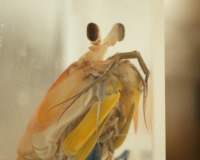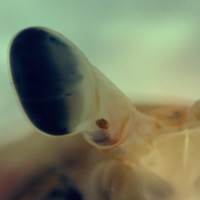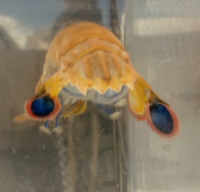Mantis Shrimp
Hemisquilla californiensis
What is Life?

Mantis Shrimp
We are hunting for the mantis shrimp.
All sensing has evolved to fulfil one simple function – to provide us with the specific information we need to survive. And nowhere is that clearer than
in the sense of vision. Almost all animals can see. 96% of animal species have eyes. But what those eyes can see varies enormously. So with an animal like
the mantis shrimp, you have to ask what it is about its way of life that demands such a complex visual system.
The complex structure of the mantis shrimp's eyes give it incredibly precise depth perception. We have binocular vision. We look with two eyes from a
slightly different angles, and judge distance by comparing the differences between the two images.
Each of the mantis shrimps's eyes has trinocular vision. Each eye takes three separate images of the same object. Comparing all three gives them
exceptionally precise range-finding, and the need that information to hunt their prey.

Mantis Shrimp Eye
Despite appearances, it is a dangerous animal. He has one of the hardest punches in nature. Those yellow appendages you can see on the front of his
body are called raptoral appendages. They are actually highly evolved from legs, and they can punch with tremendous force. The mantis shrimp's punch
is one of the fastest movements in the animal world. Slowed down by over 1000 times, we can clearly see its power. It can release its legs with the
force of a bullet. In the wild, the use that punch to break through the shells of their prey. But it could easily break my finger. The need to
precisely deploy this formidable weapon is one of the reasons the mantis shrimp has developed its complex range-finding ability.

Shrimp Tail Flashes
And that punch can also help explain their sophisticated colour vision. Because the coloured flashes on their body warn and other mantis shrimp that
they may be about to attack. While other colour signals have a quite different meaning. Yet reading these signals in the ocean can be surprisingly difficult.
In the deep ocean, colours shift from minute to minute, from hour to hour, with changing lighting conditions, changing conditions in the ocean,
but it's thought that even though the light quality can change tremendously, the mantis shrimp can still identify specific colours very accurately,
because of those sophisticated eyes.
The mantis shrimp's eyes are beautifully tuned to their needs. But they are very different from our eyes. With their thousands of lenses and
their complex colour vision, they have a completely different way of viewing the world. And yet there is strong evidence that the mantis
shrimp's eyes and ours share a common origin.


